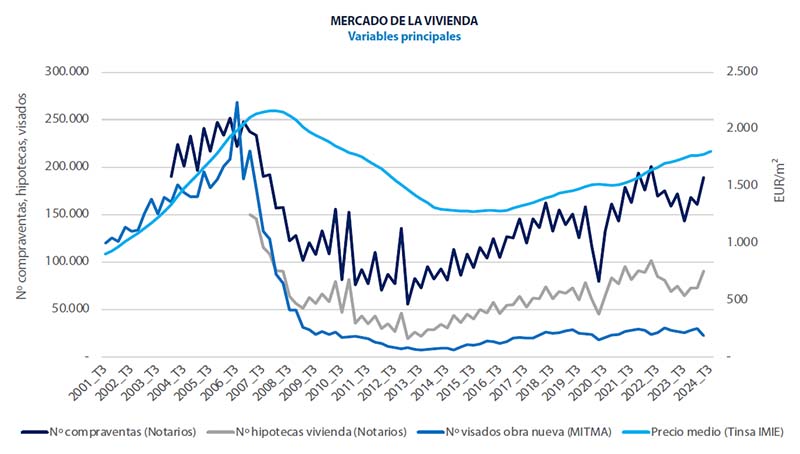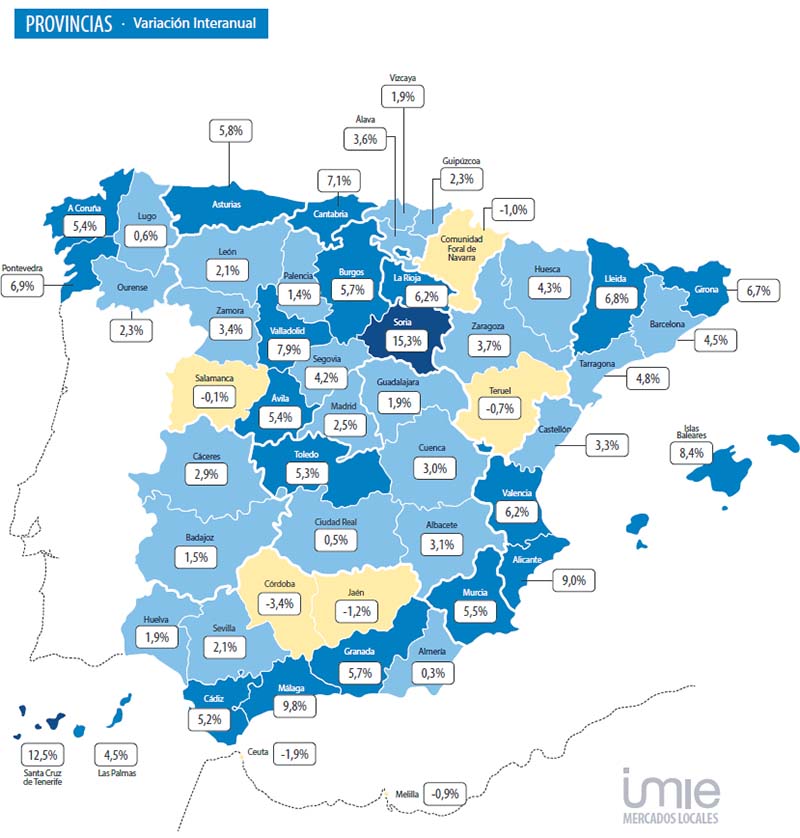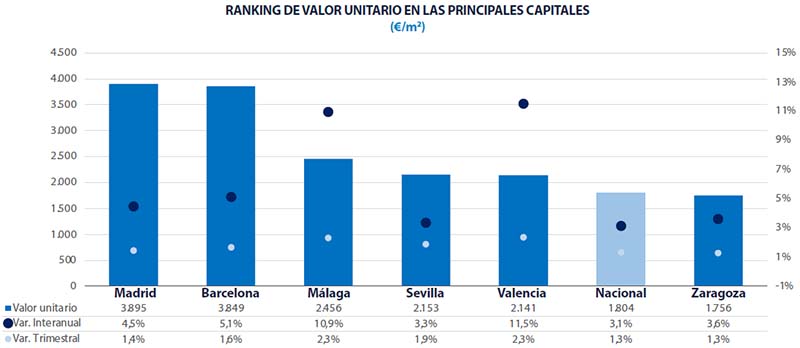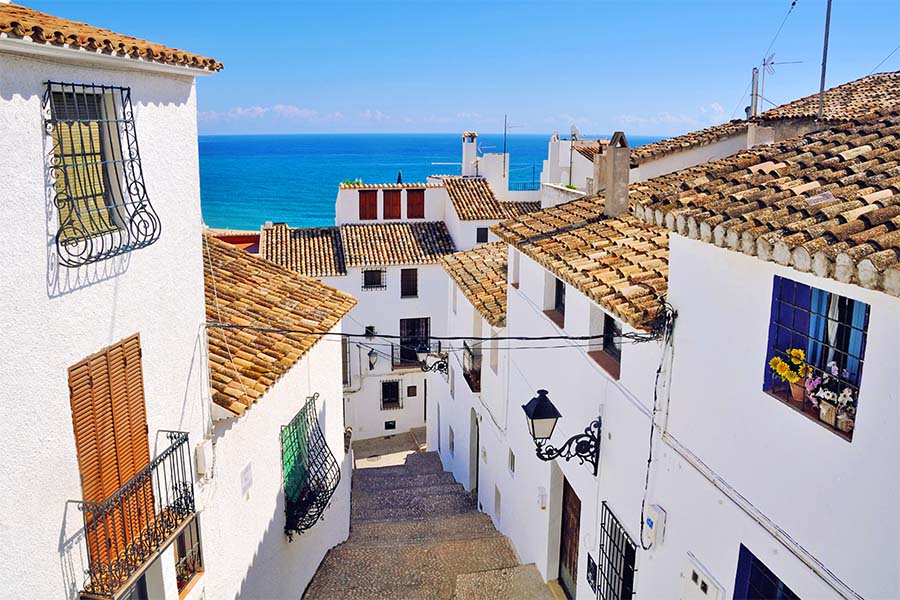We are already in the last quarter of 2024, which means another review of trends in the Spanish housing market. What is striking this third quarter, is that the average percentage increase across Spain is increasing again, after the previous stabilization. In the coastal areas, we once again see intense increases. Read all about it in the Analysis Real Estate Market Spain 2024 Q3.
General situation real estate market Spain in 2024 Q2
In the third quarter of 2024, the average price in Spain of both new and existing homes increased by 3.1% from last year and 1.3% from the previous quarter. This represents a slight increase that keeps prices close to inflation levels.
Demand for homes in Spain remains strong. Between January and July, the number of home sales and purchases increased by 8% compared to the same period last year, according to data from notaries. The number of sales is being boosted by easier access to mortgages now that the European Central Bank has stopped raising interest rates.
On the other hand, the supply of houses remains limited. Between January and May, the number of building permits increased by 14.8%. While this is a positive development, it is still not enough to meet demand in popular areas, where land is scarce. The combination of strong demand and limited supply means that house prices remain under pressure.
The chart below shows the number of sales, mortgages, building permits and the average value per square meter, plus the annual variation.

Property prices in Spain by autonomous region
In most regions, house prices are rising gradually. In 11 of the 19 autonomous regions, year-on-year price growth has strengthened or remained stable, and on a quarterly basis there is also a slight increase. Regions such as the Balearic Islands and Valencia (Comunidad Valenciana) stand out with the strongest annual growth.
Most regions have annual price increases between 2% and 6%. The Balearic Islands (+8.4%), Canary Islands (+7%) and Valencian Region (+6.8%) are above 6%. Madrid (+2.5%) and Catalonia (+3.6%) show moderate increases, but higher than in the second quarter. Especially the north coast and the islands show the greatest dynamics. In this quarter, 5 regions saw stable prices, while most showed small increases. The largest quarterly increases were in the Balearic Islands (+2.8%) and Canary Islands (+2%), among others. There were no major decreases.

Property prices in Spain by province
At the provincial level, we also see moderate increases in housing prices, with stronger growth in coastal areas.
Most provinces have annual price increases between 3% and 6.5%. The largest increases were recorded in Santa Cruz de Tenerife (+12.5%), Málaga (+9.8%), Alicante (+9%) and the Balearic Islands (+8.4%), among others.
On a quarterly basis, prices rose more than 2% in 14 provinces. The number of provinces with little change (about +-1%) fell from 29 in the previous quarter to 20 this quarter. Notable again this quarter are the Balearic Islands (+2.8%) and Santa Cruz de Tenerife (+2.8%).
In the provinces of major cities, prices increased, such as Madrid by 2.5% compared to last year and by 1.4% compared to the previous quarter. In Barcelona, the increase was 4.5% year-on-year (up from 2.4% in the previous quarter) and 1.8% quarter-on-quarter (up from 0.5% in the second quarter).
Some regions show different price trends between provinces. In Andalusia, Málaga – the Costa del Sol province – is growing much faster than other provinces. In the Canary Islands, prices are rising faster in Santa Cruz de Tenerife than in Las Palmas. In the Valencian region, the province of Alicante – which includes Costa Blanca – stands out.

Real Estate Prices in the Major Cities of Spain
Most major cities saw annual price increases between 4% and 8%. A few cities saw price increases of more than 10%, such as Santa Cruz de Tenerife (+11.5%), Valencia (+11.5%) and Málaga (+10.9%). Alicante (+8.8%) and Palma de Mallorca (+8.5%) also saw significant increases.
In employment centers such as Madrid, prices rose 4.5% year-on-year (slightly lower than the 5% in the previous quarter), while Barcelona posted a 5.1% increase (up from 3.8% previously).
On a quarterly basis, prices in most cities rose between 0.5% and 2%.
In many capital cities, prices increased more than in their province as a whole. A total of 30 capitals had higher price increases than their province. One of the biggest differences was visible in Valencia.

Conclusion real estate market Spain 2024 Q3
In the third quarter of 2024, we see housing prices rising again in Spain, both nationally and regionally. However, the supply of new homes lags behind demand, especially in popular tourist areas, putting pressure on prices.
Despite a shortage of properties, popular regions such as coastal areas and large cities remain attractive investment locations. Price increases in these areas indicate that demand remains strong while housing availability is limited. This presents opportunities for investors as the market remains tight for now and prices are expected to continue to rise.
Do you have any questions as a response to this blog, or would you like to know, for example, what is the best location in Spain for you? Contact us, our team will be happy to help you!
Source: TINSA












